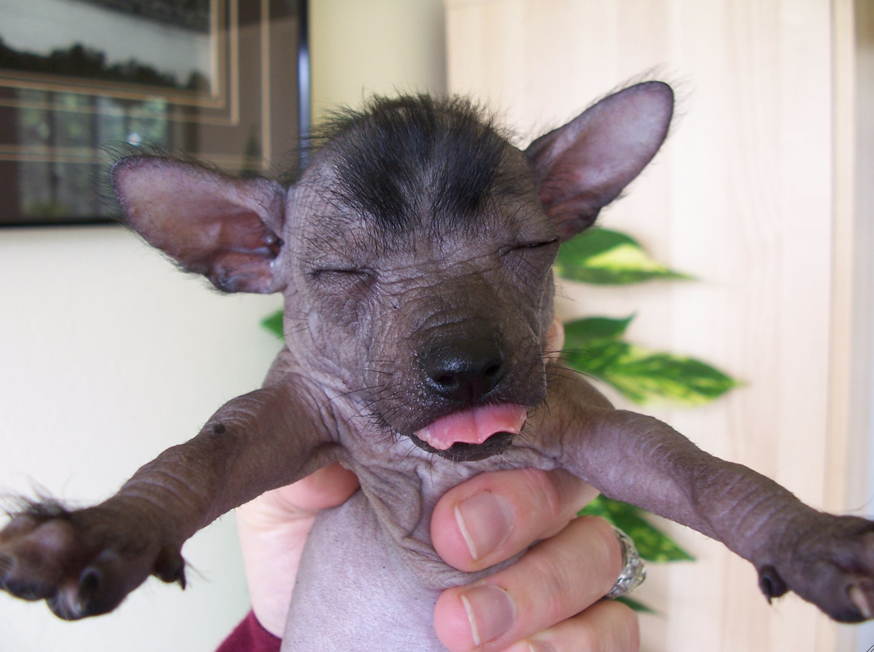Xolo Dog Breed Profile
The Xoloitzcuintli Dog Info Page
Essential description of the Xolo including history, dog types, breed traits and visual identification.
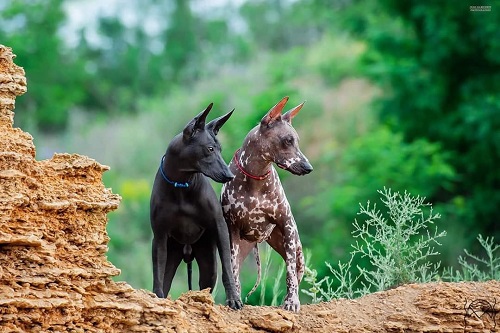
History
Pre-hispanic era
A living symbol of Mexico’s ancient civilizations, the Xoloitzcuintli has an extensive history.
Archaeological evidence indicates that Xolos accompanied man on his first migrations across the Bering Straits. Archaeologists have discovered clay and ceramic statues of dogs nearly identical to the current-day Xolo in tombs of the Toltec, Aztec, Mayan, Zapoteca, and Colima peoples. The famous pottery dogs of Colima provide evidence of the intricate bond which has existed between man and Xolo for centuries. The Florentine Codex documented dogs as the chichi itzcuintle, the tehui, the talchichi, and the xoloitzcuintle.
According to Aztec legend, the Xolo came about when the god of death, Xolotl, created a dog from the Bone of Life. Xolotl gave the dog to Man and instructed him to guard it with his life. In exchange, the dog would guide Man through the underworld on the way to heaven. The word Xoloitzcuintli combines “Xolotl”, the Aztec god of the underworld, with “itzcuintli”, the Aztec word for dog. Xolos were sometimes sacrificed and buried with their masters in order to ensure that the dog would accompany the soul on its journey in the afterlife to Mictlán, the final resting place for the dead.
In Aztec tradition, Xolos were viewed as guardians, warding off both intruders and evil spirits. They were also believed to have healing properties, and it’s easy to see why; without fur to hold in body heat, they radiate more warmth than other dogs, and are effective “heating pads” on cool nights.
Around the same time Xolos showed up in civilizations, they started to appear in art throughout Mesoamerica. The sculpture and paintings of early South American cultures include representations of dogs that look like Xolos.
Because the dogs were celebrated for their healing properties and connection to the spirit world, they’re represented in sacred art such as burial icons and representations of the gods.
Colonial era
In the 16th century, Fray Diego Durán, documented the dog market of Acolman, State of Mexico, and reported that the dogs were used during diverse festivals as food and as sacrifice. The reports of historian Bernardino de Sahagún documented the 9-level journey of the soul in the afterlife, including the central role of the Xolo: without the Xolo, the soul would never rest in peace.
The introduction and cross-breeding of European dogs into the Americas, Christianization, and Spanish colonization eliminated and transformed indigenous habits and traditions, including the Xolo breed. For a long time, the breed was considered nearly extinct. Recent genetic research indicates that the current breed does not include much of the original DNA.
Modern era
Xolos are part of 20th century art, having appeared in the life and works of artists Diego Rivera and Frida Kahlo. Rivera and Kahlo bred and raised Xolos in their shared homes. The Dolores Olmedo Museum holds many of their art works and continues to care for Xolos on its grounds.
Xolos continue to be popularized by artisans and contemporary artist in a variety of expressions, including t-shirts, jewelry, murals and photos.
In recent mythology, Xolos have been connected to the Chupacabra, a figure in Latin American folklore that preys on farm animals. Chupacabras don’t exist, but some urban legend enthusiasts believe their origins may lie in the unusual-looking hairless dog. The chupacabra legend is so pervasive that frightened farmers have mistaken Xolos for the mythological creature.
Xolos are still used as comforting healers. While modern science has debunked the idea that Xolos can cure ailments, like any dog they can offer health benefits like lower blood pressure and stress in our daily lives, and ease loneliness.
The Xolo grows more recognized each day. Due to a renewed interest and respect for indigenous and ethnic identity, social media, movies like Coco, public festivals and official recognition, it’s impossible to deny the magical qualities of a Xolo dog.
Table of Contents
Breed Definitions and Standards
The Xoloitzcuintle is an ancient natural primitive dog with an athletic, slim and pleasing physique, expressing speed, harmony and strength without appearing coarse. Possessing a clean cut outline, it has a well-proportioned body, with ample chest, well-sprung ribs, and long limbs and tail.
There are two varieties in the breed, Coated and Hairless, both identical in conformation except for coat and dentition.
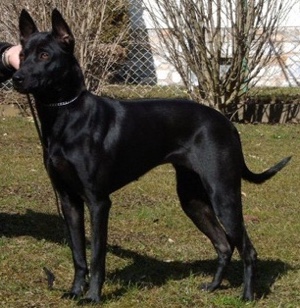
Coated Variety
A very attractive, completely short-coated dog. Hair should be tight, flat and smooth with no undercoat. The Coated variety should have the same harmonious proportions as the Hairless variety in conformation, the dentition must be complete (42 teeth), normally developed and in a normal position.
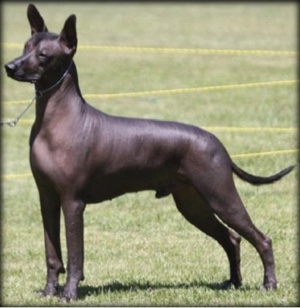
Hairless Variety
The most important characteristic is the complete or almost complete lack of any hair in the body, with a smooth and soft skin. The particular feature is that the dentition is nearly always incomplete, associated to the congenital hairless gene.
Breed Governing Organizations
Xolos were among the first breeds recorded by the American Kennel Club (AKC). A Mexican dog named ‘Mee Too’ made breed history as the first AKC-registered Xolo in 1887. ‘Chinito Junior’, bred and owned by Valetska Radtke of New York City, became the breed’s only AKC champion to date. He earned his title on October 19, 1940. In 1959, the Xolo was dropped from the AKC stud book due to the breed’s scarcity and perceived extinction.
The Xoloitzcuintli Club of America (XCA) was founded in October 1986 to regain AKC recognition for the breed. On May 13, 2008, AKC voted to readmit the breed to its Miscellaneous Class starting January 1, 2009. The XCA is the official parent club for the breed, founded on October 26, 1986 for the purpose of regaining AKC recognition for the Xoloitzcuintli. The founding members voted unanimously to recognize all three sizes (toy, miniature and standard) and both varieties (hairless and coated) at their initial meeting.
- Toy – Height at withers (shoulder) at least 10, and up to and including 14 inches.
- Miniature – Height at withers over 14 inches, and up to and including 18 inches.
- Standard – Height at withers over 18 inches, and up to and including 23 inches.
Despite the Xolo’s more than 3000 year history in Mexico, the breed did not receive any official notice in its homeland until the 1950s. The Fédération Cynologique Internationale (FCI), founded in 1940, was not prepared to declare the Xolo an official purebred at that time. According to breed historian Norman Pelham Wright, author of The Enigma of the Xoloitzcuintli, Xolos began to turn up at Mexican dog shows in the late 1940s. While they were recognized as indigenous specimens of a native breed, interest in them was minimal at that time because information was scarce and no standard existed by which to judge them.
Within a decade the FCI realized that the breed would become extinct if drastic action were not taken to save it. This led to the widely publicized Xolo Expedition of 1954. With the official sanction of the FCI, Wright and a team of Mexican and British dog authorities set off to discover if any purebred Xolos still existed in remote areas of Mexico. Eventually ten structurally strong Xolos were found and these dogs formed the foundation of Mexico’s program to revive the breed.
A committee headed by Wright authored the first official standard for the breed; on May 1, 1956 the Xolo was finally recognized in its native land and, as Mexico is a member of the FCI, worldwide.
Federación Canófila Mexicana (FCM – Mexican Canine Federation) adheres to the FCI norms but does not accept coated Xolos without genetic proof; the coated variety is not permitted to compete.
FCI Breed Standards
Breed Name: XOLOITZCUINTLE
Breed Number: 234
Group: Group n°5 – Spitz and primitive types
Section: Primitive type
Date of acceptance on a definitive basis by the FCI: 11/6/1961
Official authentic language: Spanish
Date of publication of the official valid standard: 10/8/2012
Breed status: Recognized on a definitive basis
Country of origin of the breed: Mexico
Working trial: Not subject to a working trial according to the FCI breeds nomenclature
Varieties: Miniature, Intermediate, Standard
Date of publication of the standard: 1/28/2014
Download the FCI Standards – English
Descarga la Norma de la FCI – Español
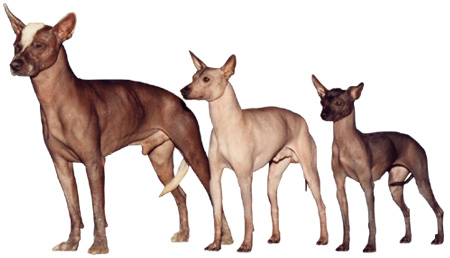
Characteristics, Temperament & Care
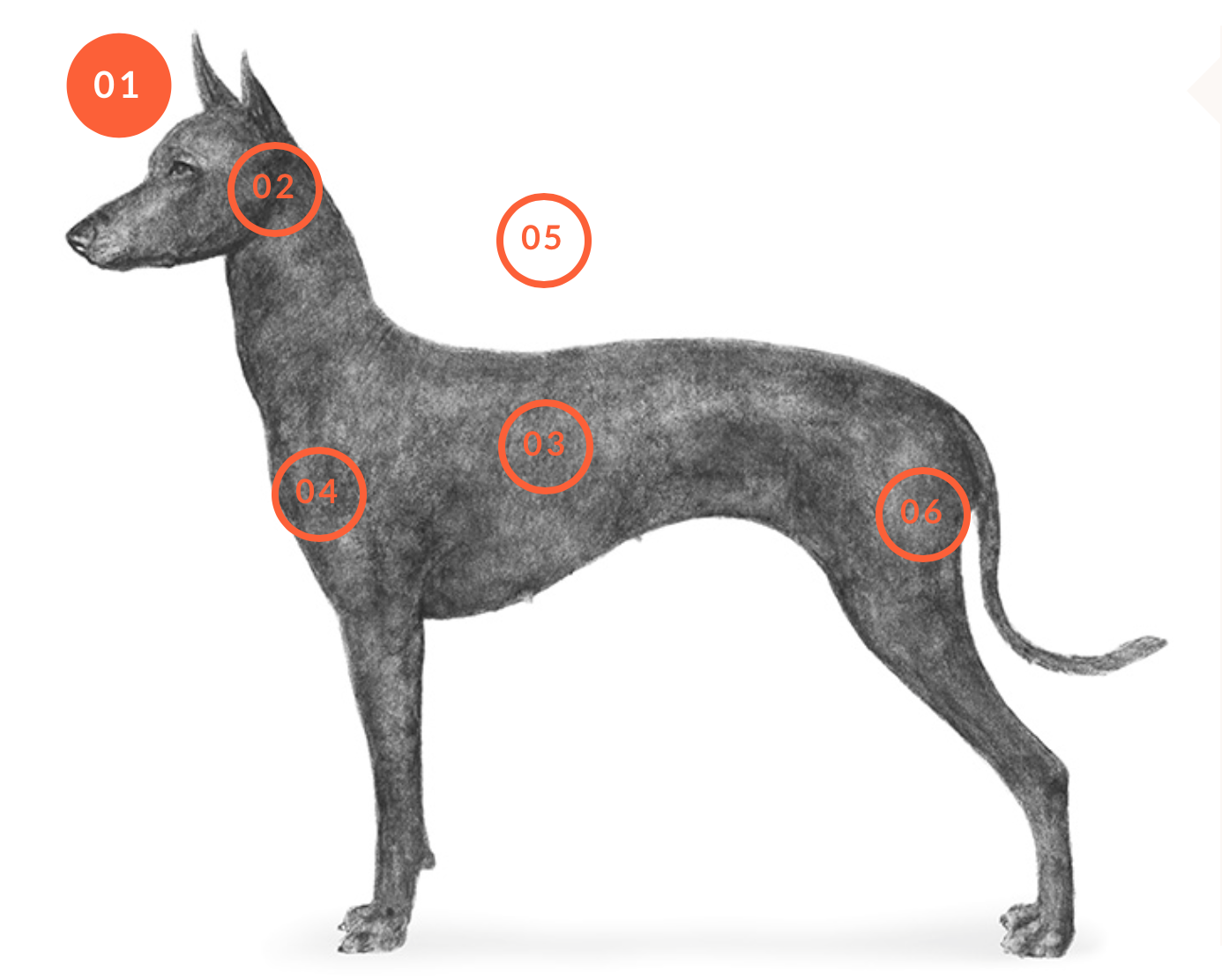
Physical Traits
The Xolo is an ancient, natural breed, molded by evolution rather than selective breeding. A Xolo is moderate in all aspects of type and conformation, never extreme or overdone. Today the breed serves as a guard and companion.-
- Appearance
- Head
- Body
- Forequarters
- Coat
- Hindquarters
The Xolo possesses a clean, graceful outline, equally combining elegance and strength. There are two varieties, hairless and coated, identical except for coat and dentition. In the hairless variety, the principal characteristic is the total or almost total absence of hair. The coated variety is covered by a short, flat coat. In conformation, all three sizes are lean, sturdy, well muscled with a spacious rib-cage, and moderate bone. The Xolo outline is rectangular, and the distance from the elbow to ground is equal to, or slightly greater than, the distance from the withers to the elbow. Typical Xolo temperament is calm, tranquil, aloof and attentive.
The Xolo expression is thoughtful and intelligent, alert and vivacious, conveying the noble and faithful character of the breed, and will show distinctive brow wrinkles when at attention. Eyes are almond-shaped and medium-sized, neither sunken nor protruding. The color varies from yellow to black, the darker being preferred, but lighter color is acceptable. Both eyes must be of the same color. The eye rims may be less pigmented on light colored dogs. Light or spotted eye rims are tolerated but not preferred.
Neck is long, elegant, slightly arched, blending smoothly into the shoulders. In dogs less than one year of age, wrinkled skin may be present. In adults, the skin on the neck is smooth and dry, without wrinkles. Topline is level with slight arch over loin. Body is well developed. The brisket should reach to point of elbow. The ribcage is deep and oval, of good length, with sufficient ribspring to produce a rounded shape, but never barrel shaped. The loin is muscular, with a smooth underline showing a slight tuck up. Back is level and firm. Croup is well muscled, slightly rounded, and broad. It should not be flat or steeply angled. Tail is set low, continuing smoothly off the angle of the croup, long and fine, reaching to the hock. When the dog is moving, the tail is carried in a graceful curve, but not over the back. It is held down in a relaxed position when the dog is at rest. A short or curled tail is a serious fault.
Shoulders are covered with smooth muscle, long and sloping. Shoulder blades are flat and well laid back. Upper Arm (humerus) is equal or slightly longer than scapula, angled to place the forelegs well under the body. Elbows are firm and tight, allowing for reach but not so loose to as to allow for elbowing out, nor so tight as to create toeing in or out. Legs are long, straight, and parallel, when viewed from all sides, set well under the body to allow a long stride. Pasterns are flexible, strong and straight, turning neither in nor out. Feet are harefeet, webbed, with well-arched toes. Thin soft pads, splayed feet or rounded feet are a serious fault. Toenails are to be dark on dark colored dogs, light on light colored dogs. Dewclaws may be removed.
The principal characteristic of the hairless variety is the absence of hair, however a small amount of short, coarse hair is permitted on the top of the head, the feet, and the last third of the tail to the tip. The absence of hair in those areas is not to be penalized. Hair on any other areas is a serious fault. Hair may be any color. The skin is tough, protective, smooth and close fitting. Moderate head wrinkles are permitted but loose or wrinkled skin on the body is a fault. The coated variety is completely covered with a short, smooth, close fitting coat. Long, soft or wavy hair is a serious fault in either variety.
Contrary to belief, the hairless variety is not considered hypoallergenic; the hairlessness is only less likely to affect people with allergies. The Xolo does produce dander, saliva and urine, which carry allergens and can produce diverse effects in humans.
The Xolo possesses moderate rear angulation, in balance with the forequarters. The bones of the first and second thigh are approximately equal in length, and the combined angle should place the front edge of the back paw directly under the rearmost point of the pelvis with the hock perpendicular. Legs are straight and well muscled. Stifle is moderately bent. Hocks are short, sturdy and straight, turning neither in nor out. Dewclaws may be removed. Feet are the same as the front feet.
Temperament
Xolos are generally a healthy, happy companion that enjoys outdoor walks and play. Xolos need a consistent training regiment and clearly defined boundaries. Good nutrition is very important, especially considering its typically weak dental condition, but easy care and little grooming.
Care and Lifespan
Coated Xolos require occasional brushing of short hair, and Hairless Xolos should be cared with a non-comedogenic lotion to hydrate the skin. Despite its cautious approach to strangers and loud noises, the peaceful and loyal nature makes a Xolo great as a guardian, friend, and playmate for children as well as adults.
Xolos enjoy an expected lifespan of 14-20 years.
Colors and Markings
Recognized colors are:- Black* 007
- Brindle* 057
- Bronze* 060
- Dark Brown* 078
- Fawn* 082
- Gray* 100
- Liver* 123
- Palomino* 282
- Red* 140
- White* 199
- Black & White 019
- Black, White & Tan 034
- Merle 131
- Pink & Brown 518
- Tan 195
- White & Black 202
- Black Markings* 002
- Spotted Marking* 021
- Tan Markings* 012
- White Markings* 014
Standard Visualization
Illustration courtesy of Xoloitzcuintli Club of America.
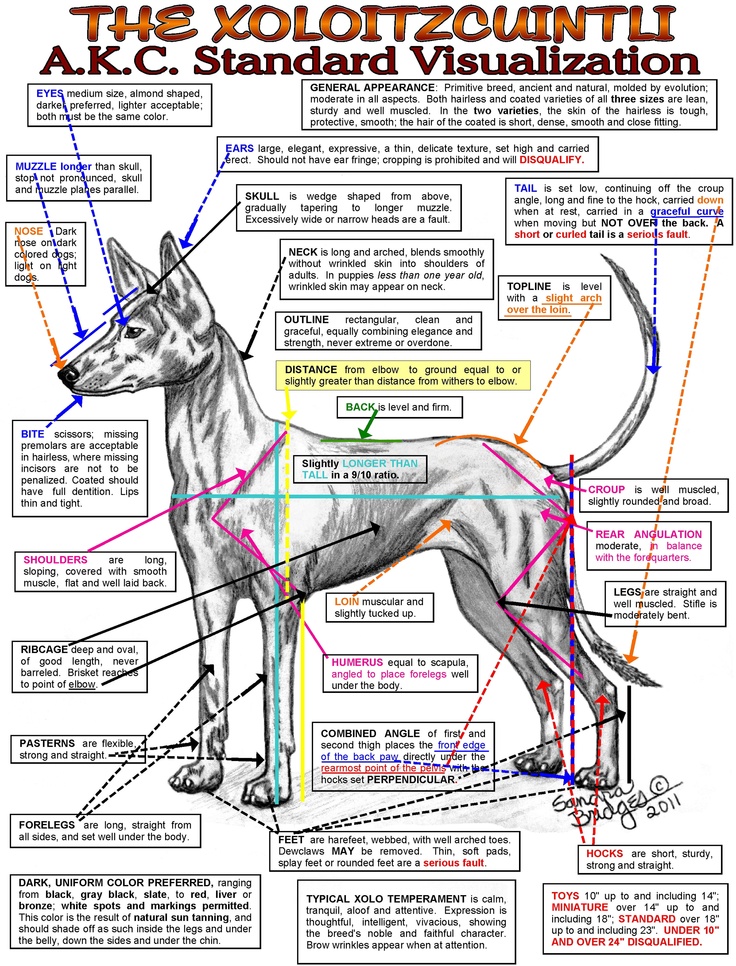
Fast Facts
- The Xoloitzcuintli was the American Kennel Club’s 170th officially-recognized breed, admitted in 2010 and competed in 2011.
- The name is pronounced show-low-etz-queent-lee.
- Other names for the breed include Mexican hairless and Tepezcuintli.
- Look carefully – acceptable alternate spellings of the Xolo are Xoloitzcuintli, Xoloitzcuintle, Xoloitzquintle, and Xoloescuincle.
- The breed was first recognized by the Mexican Kennel Club (now, FCM) on May 1st, 1956.
- Xolos appear in paintings by famous Mexican artists such as Diego Rivera and Frida Kahlo.
- The professional football (soccer) club in Baja California Norte is known as the Tijuana Xoloitzcuintles de Caliente.
- The Xolo has been recognized as Mexico’s National Dog (year unknown), the state dog of Colima (year unknown – citation needed), and as Mexico City’s Official Dog (2016 and 2020 – citations needed).
- The Xolo has 3 sizes – toy, miniature (intermediate), and standard – and 2 varieties, hairless and coated.
- The word Xoloitzcuintle is derived from the name of the Aztec god Xolotl (twin brother of the god Quetzalcoatl) and the Aztec word for dog, itzcuintli.
- The Kennel Club of Great Britain registers and allows Xolos to be shown – but they are still erroneously known as “Mexican Hairless”.
- Xolos enjoy an expected lifespan of 14-20 years.
Sources and References
Thanks to these sites and resources for their information and continuing efforts to educate government agencies, breeders, owners and the public about the Xolo.
XCA: Xoloitzcuintli Club of America
AKC: American Kennel Club
FCM: Federación Canófila Mexicana
Petful.com
Rover.com
Wikipedia – English and Spanish
